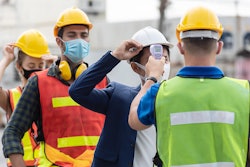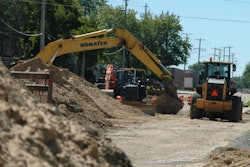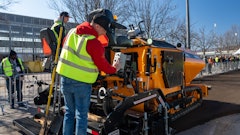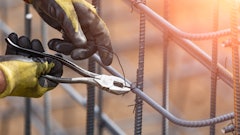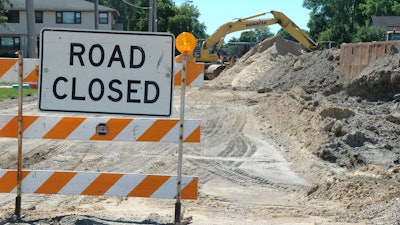
The Associated General Contractors of America (AGC) and Sage Construction and Real forecast the COVID-19 pandemic to shrink construction demand, decrease new hires and increase cancelled or delayed production in 2021.
AGC and Sage conducted the 2021 Construction Outlook National Survey, which accumulated 1,329 responses, and discussed the results in a Facebook Live event with a panel of contractors on Thursday. The survey concluded that most companies anticipate declining demand for work in all construction categories excluding water and sewer, warehouse and other healthcare facilities (clinics, testing or screening, or medical labs).
AGC Chief Economist Ken Simonson forecasts the construction industry won’t return to pre-pandemic levels anytime soon. Of the survey participants, 59% of companies had to postpone production and 44% saw project cancellations, resulting in lost income in 2020.
Challenges to Recovery
As 2021 begins, construction project delays and cancellations continue. Already, 18% of survey participants have postponed projects that were scheduled to begin in the first half of the year, whereas 5% of companies have experienced production cancellations in 2021.
“Contractors expect the market for most types of construction to shrink in 2021, as the pandemic undermines the demand for projects,” Simonson said. “The net rating, the percentage of respondents that expect the available dollar value of projects to shrink compared to the percentage who expect it to expand, is negative in 13 of the 16 categories included in the survey.”
Companies in retail construction are the most pessimistic with a net rating of -64% . Lodging (-58%), private office (-58%) and higher education (-40%) categories all have similar concerns about the pandemic’s impact in 2021.
Continued production declines and cancellations have convinced most construction companies to forecast six or more months to regain pre-pandemic levels. And many companies have seen spending increase due to the pandemic’s impact.
According to Ranger Construction CEO Bob Schafer, these schedule interruptions stretched production time and added to contractors’ costs. Companies endured unanticipated costs for protective equipment, materials used for remote working capabilities, COVID-19 testing, paid time off due to COVID exposure and delayed production expenses. Those costs are now part of budgets.
“What we are seeing now is a lot of increases in cost. We are seeing significant material increases: steel, cement, liquid asphalt, aggregates all going up,” said Schafer.
With significant material cost increases and production expected to decline, relatively few companies plan to add workers in 2021. Simonson says the construction workforce lost a devastating 1.4 million jobs early in the pandemic.
Paycheck Protection Loans helped many companies bounce back and rehire. However, only 35% of companies plan on increasing headcount in 2021, while 24% anticipate decreasing their workforce throughout the year. During the Facebook Live, the three contractors all admitted to a shortage of skilled labor in their hiring processes.
COVID Propels Technology Adoption
In order to alleviate some impacts of the pandemic, many companies implemented technology to streamline production and reduce face-to-face communication.
Michael Kennedy, president of KAI Enterprises, reported that the company won many work projects via the online platform Zoom. KAI also integrated a new technology platform that allowed bankers and architects to see the jobsite, schedule and input photos — allowing production to continue virtually and at a safe distance.
All three contractors reported some resistance to integrating new technology, but Rosie Biondo, president of Mark One Electric, said the company had 90% success in the transition to its new purchasing platform.
Technology adoption comes with advantages and disadvantages. On one hand, most software helps companies streamline production; but overcoming new software’s learning curve sometimes presents efficiency challenges.
According to Dustin Anderson, vice president of Sage, resistance to new technology is common in any industry. However, it is important that companies invest in their people and promote engagement, which can lower resistance by making technology a benefit for them rather than a disadvantage.
Moving Forward
AGC and Sage forecast a challenging year ahead. However, adapting to the current environment and implementing of technology can help contractors survive. Construction is an essential part of the economy and therefore AGC plans to work with companies and the federal government to propel the construction industry further.
This includes securing a COVID relief package for companies affected by the pandemic and creating workforce campaigns that improve availability of skilled labor.
“In conclusion, I think we are going to have a challenging year, but you know, I am a contractor that has been in business for a long time,” said Biondo. “You can find work, it’s your job to find work. It is my job to make sure I work my team, so we dig in deep. We have cost-cutting measures in place and we find a way to continue to win.”
Key takeaways
- Decreasing project demand
- Increasing project cancellations and production delays
- Higher material costs
- Decreasing new hires
- Technologies can streamline production and reduce face-to-face communication, alleviating some pandemic impacts
Steps to help contractors get through 2021
- Align strategic plan with decreasing revenue
- Communicate openly with banks and bonding companies — alleviate foreseen problems before they become issues
- Plan to maintain company culture while working remotely
- Strategize how to utilize PPE Relief the right way
- Follow COVID-19 procedures and regulations
- Report any injuries and COVID related illnesses







